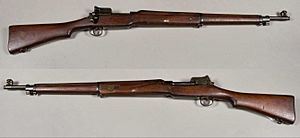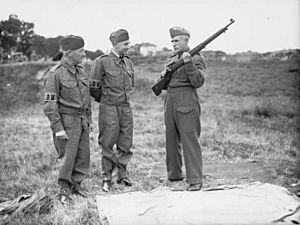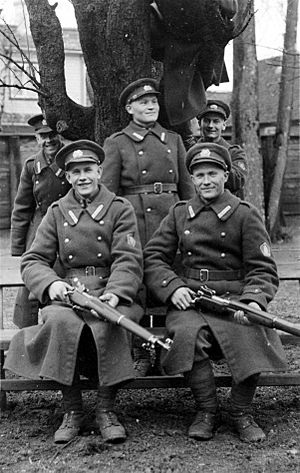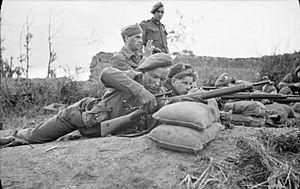Pattern 1914 Enfield facts for kids
Quick facts for kids Rifle, .303 Pattern 1914 |
|
|---|---|

Pattern 1914 Enfield
|
|
| Type | Service rifle Bolt-action rifle Sniper rifle |
| Place of origin | United Kingdom |
| Service history | |
| In service | 1916–1945 (UK) |
| Used by | See Users |
| Wars | World War I Estonian War of Independence Spanish Civil War World War II Korean War Portuguese Colonial War 1958 Lebanon crisis Lebanese Civil War Soviet–Afghan War |
| Production history | |
| Designed | 1914–1915 |
| Produced | 1915–1917 |
| No. built | 1,235,298 total |
| Variants | Sniper (telescopic and unmagnified), grenade launcher, US M1917 rifle |
| Specifications | |
| Mass | 9 lb 6 oz (4.25 kg) unloaded |
| Length | 46.25 in (1,175 mm) |
| Barrel length | 26 in (660 mm) |
|
|
|
| Cartridge | .303 British |
| Calibre | .303 inch (7.7mm) |
| Action | Modified Mauser turn bolt-action |
| Rate of fire | Manual, as determined by skill of operator |
| Muzzle velocity | 2,380 ft/s (725 m/s) |
| Effective firing range | 800 yd (732 m) |
| Feed system | 5-round, ... clip reloading |
The Rifle, .303 Pattern 1914 (often called the P14) was a British service rifle. It was mainly used during World War I. Most of these rifles were made in the United States. It was a bolt-action rifle, meaning you had to manually pull a bolt back and forth to load each shot. It held 5 rounds (bullets) inside. The P14 was used as a sniper rifle and also by backup troops. It was officially retired in 1947. This rifle was an improved version of an earlier experimental rifle called the Pattern 1913 Enfield. It also led to the creation of the U.S. Rifle M1917 Enfield.
History of the P14 Rifle
During the Second Boer War, British soldiers faced a problem. Enemy soldiers used Mauser rifles that could shoot very accurately from far away. These rifles used a smaller, faster bullet. Because of this, the British military decided they needed a new, more powerful bullet. In 1910, they developed a "magnum" bullet called the .276 Enfield.
A new rifle, the Pattern 1913 Enfield (P13), was designed to fire this powerful new bullet. It used a modified design similar to the Mauser rifle. However, when World War I began, it was too difficult to start making a brand new rifle and bullet in large numbers. It would have caused too many problems with supplies. So, the P13 was never widely produced.
How the P14 Was Made
The main company asked to make the P14, Vickers, could only produce a few rifles. This meant the P14 was not the main rifle for the British army at first. The Short Magazine Lee–Enfield remained the standard British rifle during World War I.
However, Britain needed many more weapons. They also didn't have enough factories to make them. So, the British government hired American companies to build the P14. These companies were Winchester, Remington, and Eddystone. Eddystone was a special company set up by Remington just to make the P14. They continued making the rifles until the U.S. joined the war in 1917.
Each factory made parts that were slightly different. This made it hard to swap parts between rifles from different makers. Because of this, the rifle's official name depended on who made it. For example, a Pattern 1914 Mk I W was a Mark I rifle made by Winchester. 'R' meant Remington, and 'E' meant Eddystone.
There were some problems at first with how the rifles were made and the quality. The first P14 rifles were not accepted by British inspectors until February 1916. In December 1916, a small change was made to the bolt. This updated version was called the Mark I*. These rifles were still named with the letter of their maker (W, R, or E). The older Mark I rifles were then mainly used for training and marked DP (Drill Purpose).
The P14 was mostly used as a sniper rifle during World War I. It was found to be more accurate than the standard Lee–Enfield rifle. Some P14s were given special sights for snipers. These included "fine-adjustment" sights or special telescopic sights. Winchester-made rifles were often preferred for snipers because they were thought to be better quality.
In total, Winchester made 235,293 rifles. Remington made 400,000, and Eddystone made 600,000. This added up to 1,235,293 P14 rifles.
When the U.S. joined World War I, they changed the P14 design slightly. It was then made in the same factories as the P14. This new rifle was called the Model of 1917, or sometimes the M1917 Enfield. It used the standard American .30-06 Springfield bullet. The M1917 became very popular and was made in much larger numbers than the American Springfield M1903 rifle.
In 1926, the British military renamed the Pattern 1914 Enfield as the No3Mk1.
Before and during World War II, over 670,000 P14 rifles were used again. They were repaired and updated in the UK. This update was called the "Weedon Repair Standard." It involved checking the rifles, removing some old sights, and fixing anything needed. After the British forces lost many weapons at Dunkirk in 1940, the No3Mk1 rifles became very important.
The rifle was also used again as a sniper rifle in World War II. The U.S. also sent some M1917 Enfield rifles to the UK as part of a program called Lend-Lease. However, these rifles used a different bullet (.30-06 Springfield). So, they had to be clearly marked with a 2-inch wide red band on the stock. The Australian Army also used some P14 sniper rifles during World War II.
Once enough new Lee–Enfield and No4 rifles were made, the No3Mk1 rifles were mainly given to the British Home Guard. They were also still used as sniper rifles. Some sniper rifles were even used during the Korean War.
The P14/No3Mk1 was officially retired from British service in 1947.
Many extra P14 rifles were sold to countries in the Commonwealth, like Canada, New Zealand, Australia, and South Africa. They became popular for target shooting and were often changed for hunting.
How the P14 Was Designed

The P14 rifle was designed to use the standard .303 British bullet. It had a five-round magazine built into the rifle. It looked very unique with its "ears" that protected the sights, a special "dog-leg" shaped bolt handle, and a "pot-belly" magazine.
The way it worked was similar to a Mauser rifle, but it also had some features from the Lee–Enfield. It was designed for fast shooting. The rifle would cock (get ready to fire) when you pushed the bolt forward to close it. This was a feature that British soldiers liked for quick firing. Other armies, like the U.S. or Germany, preferred rifles that cocked when you opened the bolt. The P14 was considered a very advanced rifle for its time. Some even said it was the most advanced service rifle of World War I.
The Pattern 1914 Enfield had a large, strong bolt action made from a special metal called nickel-steel. The bolt moved a long way because it was originally designed for the larger .276 Enfield bullet. The bolt had a claw that pulled out the empty bullet casing and two locking parts at the front. There was also a safety lock at the back, made by the base of the bolt handle.
The bolt was much faster and smoother to use than a Mauser bolt. The special "dog-leg" shaped bolt handle was low and placed the knob close to the shooter's hand. This made it easier and faster to load and fire. Like the Lee–Enfield, the safety catch was under the shooter's thumb and could be used quietly.
Because the rifle was first designed for the larger .276 Enfield bullet, its internal magazine could actually hold six of the smaller .303 British bullets. However, the clips used to load the rifle only held five bullets. Unlike some other rifles, the P14 did not have a "magazine cut-off." This feature would allow a soldier to load one bullet at a time while keeping the bullets in the magazine ready for later.
The rifle had iron sights. The main rear sight was an opening (aperture) set for 300 yards. It also had a ladder-like sight that could be flipped up. This ladder sight was for shooting at distances from 200 to 1000 yards, and then from 1000 to 1650 yards. The ladder sight moved up and down, but it couldn't adjust for wind. The rear sight was protected by strong "ears." This sight was faster and more accurate than the sights on many other rifles of the time. The front sight was a post protected by "wing guards." It was set at the factory.
The P14's advanced sights and long sight distance helped it earn a good reputation for being accurate. Snipers in World War I thought it was more accurate than the standard Short Magazine Lee-Enfield Mk III rifle.
Compared to the Lee–Enfield, the P14 was more accurate and stronger. However, it was also heavier. The Lee–Enfield Mk III weighed about 8 pounds 10 ounces (3.9 kg) empty. The P14 also held only half as many bullets in its magazine. This meant the Lee–Enfield could fire much faster. Before World War I, British soldiers were trained to fire very quickly. This was called the "Mad Minute" qualification. While the Boer War showed the need for accuracy, World War I often needed a high volume of fire, which the Lee–Enfield was better at.
Users
 Afghanistan
Afghanistan Australia
Australia United Kingdom
United Kingdom Canada
Canada China: A Chinese general named Zhang Zongchang bought 6,000 P14s from Latvia. A version that used a different bullet was also made for China.
China: A Chinese general named Zhang Zongchang bought 6,000 P14s from Latvia. A version that used a different bullet was also made for China. Egypt
Egypt Estonia
Estonia Ethiopian Empire: Got these rifles after World War I.
Ethiopian Empire: Got these rifles after World War I. France: Used by Free French Forces during World War II.
France: Used by Free French Forces during World War II. Greece
Greece Latvia: Used from 1918 to 1940 by the Latvian Army and Border Guard.
Latvia: Used from 1918 to 1940 by the Latvian Army and Border Guard. Lithuania
Lithuania India
India Ireland
Ireland Israel
Israel Netherlands: Used by some units of the Royal Netherlands East Indies Army in Australia.
Netherlands: Used by some units of the Royal Netherlands East Indies Army in Australia. New Zealand
New Zealand Nigeria
Nigeria Norway Received from Allied air drops to the resistance during WW2 and given by Britain to the Norwegian Brigade during the occupation of Germany in 1947. Returned to Britain in 1952 in exchange for P-17 rifles.
Norway Received from Allied air drops to the resistance during WW2 and given by Britain to the Norwegian Brigade during the occupation of Germany in 1947. Returned to Britain in 1952 in exchange for P-17 rifles. Pakistan: Used by the Pakistan Army in the Indo-Pakistani War of 1947.
Pakistan: Used by the Pakistan Army in the Indo-Pakistani War of 1947. Poland Used by the Police and the KOP before World War II.
Poland Used by the Police and the KOP before World War II. Portugal
Portugal Spanish Republic: 250 P14 rifles from Estonia were used during the Spanish Civil War.
Spanish Republic: 250 P14 rifles from Estonia were used during the Spanish Civil War. Union of South Africa Given to the Union Defence Force to help arm troops for the invasion of German South-West Africa in 1915.
Union of South Africa Given to the Union Defence Force to help arm troops for the invasion of German South-West Africa in 1915.
See also
- British military rifles





